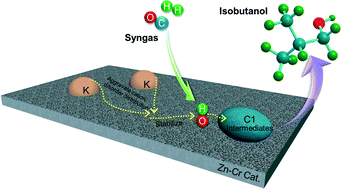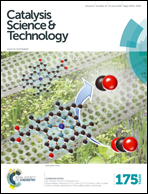The role of potassium promoter in isobutanol synthesis over Zn–Cr based catalysts†
Abstract
A series of Zn–Cr oxide nanoparticles with different contents of potassium promoter is obtained by coprecipitation and post-calcination methods. Transmission Electron Microscopy (TEM), Powder X-Ray Diffraction (XRD), X-ray photoelectron spectroscopy (XPS) and Fourier Transform Infrared spectroscopy (FT-IR) were used to confirm the structure of the different Zn–Cr oxides. The results demonstrate that the potassium promoter would tailor the microstructure of the Zn–Cr spinel by affecting the cation distribution between the tetrahedral and octahedral vacancies. Furthermore, the potassium promoter also affects tremendously the state of the oxygen species on the surface over the Zn–Cr spinel. Both the population and stability of the oxygen species could be enhanced by the potassium promoter. In addition, the surface hydroxyl species could facilitate the formation of formate, which is a very significant intermediate C1 species for alcohol synthesis. The catalyst activity and isobutanol selectivity are closely related to the content of the potassium promoter, clearly demonstrating that the potassium promoter should be one of the crucial factors to consider to enhance the catalytic performance for isobutanol formation over the Zn–Cr catalysts.


 Please wait while we load your content...
Please wait while we load your content...